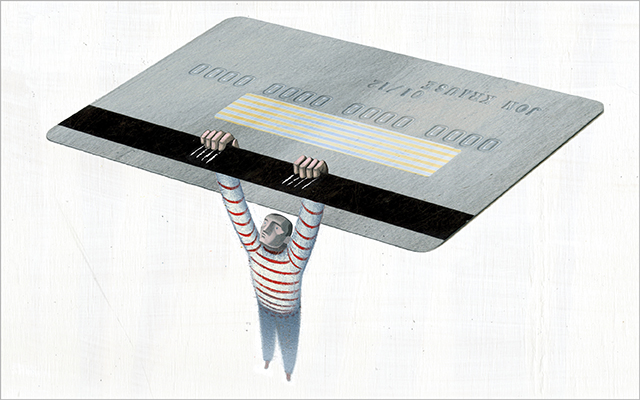The woman to my left looks perplexed, and the entire room has erupted into mild pandemonium.
Fifteen couples have gathered here for a five-week course called “Couples and Money,” and the teacher has just given the homework: Figure out expenses for the week, take that much cash out of the bank, then put all credit and debit cards in a drawer and leave them there. In other words, all the week’s purchases must be made with cash.
My neighbor insists that there must be exceptions — what about buying gas? Don’t you have to use a credit card before the pump will start? “You can go inside and pay for the gas with cash,” the instructor suggests.
Our teacher is Ruth Hayden, a financial educator and counselor with a private consulting practice in St. Paul, Minn. She is a frequent guest on public radio and the author of two books on money management: How to Turn Your Money Life Around: The Money Book for Women and For Richer, Not Poorer: The Money Book for Couples. She seems unfazed by the uproar in the room. Maybe even a little pleased. Our panic is making her first point for her — that money is highly emotional territory.
Hayden began offering classes because she couldn’t keep up with the demand for her counseling services. Clients were waiting as long as a year to get an appointment, while she kept seeing studies showing money as the top cause of divorce. To Hayden, it was obvious that finances and emotions were connected. The classes help people, she says, because they’re about more than numbers.
Hayden practices “behavioral finance,” which links money behaviors to emotional conditioning. She sees the way we spend, earn and save (or don’t) as the result of beliefs, which she defines as “emotional conclusions that feel like truths.”
Those beliefs (that it’s ridiculous to spend money on X, that the cost of Y is no object) are the result of ideas we learn as children. Until we begin to manage our emotional stories about money, behaviors don’t change — no matter what happens to the numbers.
This is why the first exercises in Hayden’s class involve identifying and dismantling the hold these stories have on us — and on our relationships.
Three Models for (Not) Dealing With Money
While everyone in the class has different issues and incomes, Hayden reveals that most of us likely fall into one of three patterns when it comes to communicating about money.
The first is acquiescence: One partner handles the finances while the other agrees to leave him or her in charge. This seems sensible enough, but when one party calls all the shots, Hayden notes, it’s not a partnership.
Other couples opt for silence, choosing to avoid the subject of money altogether. These couples often claim not to care about money or that they prefer not to think about it. Yet, when they are forced to address financial matters (usually at the point of crisis), they have no idea how.
Then they may slip into the third model, which Hayden calls “fighting and fussing.” Many couples use fighting about money as their routine mode of communication. Others bicker only when acquiescence and silence fail.
Even though most couples have a primary pattern, we protect our relationships by moving between patterns. Staying in one pattern exclusively will cause implosion, Hayden says, but staying stuck between them erodes intimacy over time. To move beyond these dysfunctional patterns, she tells us, first we have to look at our pasts.
Training, Beliefs and Behavior
Hayden explains that “money beliefs” are formed when we’re children, as we observe the financial behaviors of the adults around us.
She offers the example of a young couple in her practice trying to figure out where to cut spending. While looking at expenses, the wife suggested her husband might give up his underground parking spot, which costs several hundred dollars a month. The husband responded that he would rather give up their marriage than give up his parking.
Suspecting there was more to the story, Hayden asked the husband, a young attorney, about his childhood. She learned that when he was a teen, his father filed for bankruptcy, and they had to move away from their small town in shame. His father died shortly afterward. Not surprisingly, the man had adopted an unconscious belief that if he couldn’t display his secure financial status to his colleagues (in this case, with an expensive parking space), he might die of humiliation.
Not all money beliefs are this dramatic, Hayden says. More often, they simply enforce our sense of the “right” and “wrong” things to do with money. Though highly subjective, our money beliefs convince us that our own way with money is correct, while our partner’s might seem not only misguided but ridiculous. This leaves no room for differing perspectives.
Discovering the true basis of one’s money “reasoning” often reduces the emotional charge related to perceived financial needs. It also gives more room to compromise.
When the lawyer started to see his conviction as conditioning, he realized that letting go of his parking spot would not kill him. Similarly, if you realize your compulsion for premium jeans comes from a childhood spent in worn, highwater pants, you become less likely to raid the store to check for new pairs when you don’t really need them.
To help individuals identify which stories are driving their financial habits, Hayden invites students to do a writing exercise that delves into early money histories and helps clarify where beliefs were founded. You can find this money-history questionnaire in her book For Richer, Not Poorer: The Money Book for Couples.
Blame and Shame
Hayden asks each couple to sign an agreement promising to renounce blame for the duration of the course. Making the same small gesture in our own lives has a revolutionizing effect on money conversations with our partners.
For example, if a couple has sworn off blame, one of them can’t say, “If it weren’t for your insistence on buying X, we’d have plenty of money saved.” They’re left without the option of dumping all the responsibility on one party; this includes one person accepting the blame and internalizing it as shame. Partners are forced to find a way to discuss money on equal footing.
That’s essential. In almost every case, Hayden teaches, both parties are responsible for their financial issues. And both have something to contribute to the solution. For real change to happen in a couple’s financial life, everyone involved has to alter his and her behavior.
Blame keeps couples stuck in revolving-door money patterns, because at least one person believes he or she is “right” and shouldn’t have to change. The first step to avoiding this trap, Hayden believes, is for each individual to recognize that his or her partner is not wrong for having a different way of doing things.
“Money is like a pencil,” she says. “It’s simply a tool to do something with. Your beliefs tell you what you should or shouldn’t do with the tool, and when you see your partner do something different with this tool that doesn’t feel right to you, you will be critical. You’ll blame your partner, or anyone who doesn’t work with the tool the way you think it should be used.”
Hayden says a strong financial partnership requires developing a new set of tools. This means dealing with money without relying on one person to handle the finances, or by having both people burying their heads in the sand, or by engaging in endless battles. It requires new and different tools.
“Couples have to practice a new model,” Hayden says, which is why she teaches what she calls “the four cornerstones” of successful couple money management. Her paradigm relies on commitment, respect, trust and compromise.
Explore Hayden’s four cornerstones in “For Love and Money: The Sequel”.





This Post Has 0 Comments